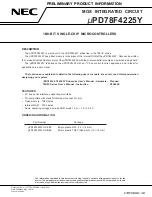
7
- 30
7.6 File Transfer Function (FTP)
7
COMMUNICATION USING BUILT-IN ETHERNET
PORTS OF CPU MODULE
(4) FTP command descriptions and file specification methods
(a) FTP command descriptions
The FTP operation commands (on the FTP client (external device) side) which
can be used in the Built-in Ethernet port QCPU are described below.
(b) File specification methods
File specification method which is specified during execution of an FTP operation
command (on the FTP client side) is described below.
• For the Built-in Ethernet port QCPU, files are specified using drive names and
file names.
• When specifying a file in the Built-in Ethernet port QCPU using the FTP
function, specify the target file in the following order.
[Specification format] Drive name : \ File name . extension
[Specification example] 3:\MAINSEQ1.QDR
[Specification details]
1) Drive name (Drive No.)
Specify the drive name of the file transfer target memory.
For the correspondence between Built-in Ethernet port QCPU target memory
and drive name, refer to Table7.7.
2) File name, extension
• Specify the file transfer target file.
• Specify the file name according to the rules for naming files using GX
Developer.
Characters that can be used are one-byte alphabets (uppercase),
numbers, and symbols. Lowercase alphabets cannot be used.
File name: 8 characters maximum (one-byte)
Extension: 3 characters maximum (one-byte)
Alphabets are not case-sensitive. Lowercase alphabets are treated as
uppercase alphabets.
• For the extension, the name fixed by the Built-in Ethernet port QCPU must
be used.
Specify the extension for the target file in accordance with Table7.7.
• For details on the file names and extensions, refer to the GX developer
operating manual.
• When using FTP operation commands which can target multiple files,
specify the file names and extensions within the file path name using a
wild card (* and/or ?).
* : Used for specifying all files having arbitrary characters (including no
characters) after the location where "*" is used.
? : Used for specifying all files having arbitrary characters (including no
characters) at the location where the "?" is used. (Multiple "?" can be
used.)
• Some FTP clients have restrictions on characters that can be used for file
names other than those described above.
How to read descriptions
Sections in brackets at [Specification format] can be omitted.
















































